Table of Contents
8
DEVOTIONAL PATHS TO THE DIVINE
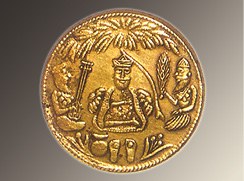
You may have seen people perform rituals of worship, or singing bhajans, kirtans or qawwalis, or even repeating the name of God in silence, and noticed that some of them are moved to tears. Such intense devotion or love of God is the legacy of various kinds of bhakti and Sufi movements that have evolved since the eighth century.
The Idea of a Supreme God
Before large kingdoms emerged, different groups of people worshipped their own gods and goddesses. As people were brought together through the growth of towns, trade and empires, new ideas began to develop. The idea that all living things pass through countless cycles of birth and rebirth performing good deeds and bad came to be widely accepted. Similarly, the idea that all human beings are not equal even at birth gained ground during this period. The belief that social privileges came from birth in a “noble” family or a “high” caste was the subject of many learned texts.
Many people were uneasy with such ideas and turned to the teachings of the Buddha or the Jainas according to which it was possible to overcome social differences and break the cycle of rebirth through personal effort. Others felt attracted to the idea of a Supreme God who could deliver humans from such bondage if approached with devotion (or bhakti). This idea, advocated in the Bhagavadgita, grew in popularity in the early centuries of the Common Era.
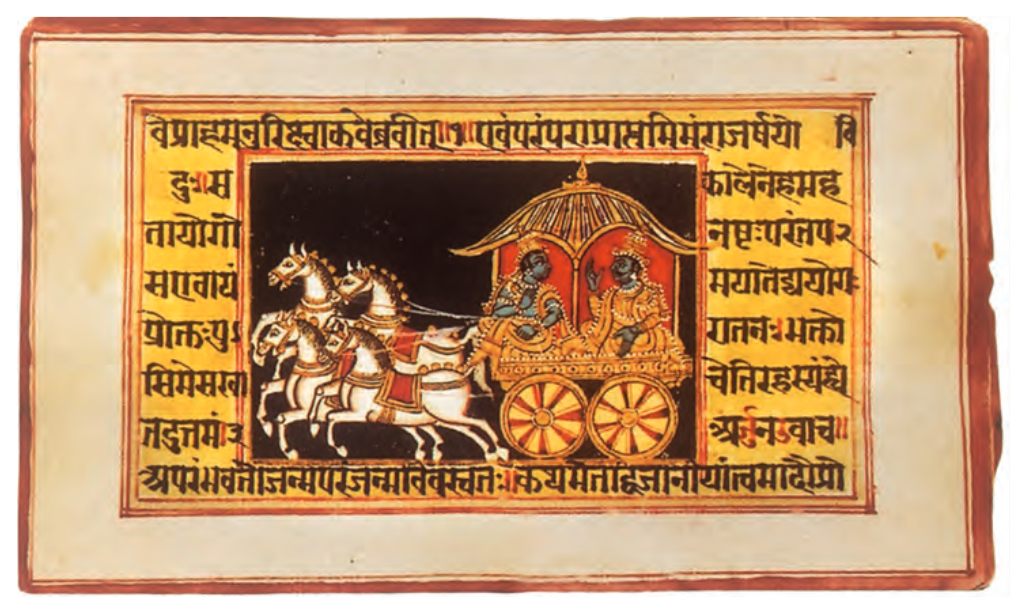
Fig. 1
A page from a south Indian manuscript of the Bhagavadgita.
Shiva, Vishnu and Durga as supreme deities came to be worshipped through elaborate rituals. At the same time, gods and goddesses worshipped in different areas came to be identified with Shiva, Vishnu or Durga. In the process, local myths and legends became a part of the Puranic stories, and methods of worship recommended in the Puranas were introduced into the local cults. Eventually the Puranas also laid down that it was possible for devotees to receive the grace of God regardless of their caste status. The idea of bhakti became so popular that even Buddhists and Jainas adopted these beliefs.
You can observe this process of local myths and legends receiving wider acceptance even today. Can you find some examples around you?
A New Kind of Bhakti in South India – Nayanars and Alvars
The seventh to ninth centuries saw the emergence of new religious movements, led by the Nayanars (saints devoted to Shiva) and Alvars (saints devoted to Vishnu) who came from all castes including those considered “untouchable” like the Pulaiyar and the Panars. They were sharply critical of the Buddhists and Jainas and preached ardent love of Shiva or Vishnu as the path to salvation. They drew upon the ideals of love and heroism as found in the Sangam literature (the earliest example of Tamil literature, composed during the early centuries of the Common Era) and blended them with the values of bhakti. The Nayanars and Alvars went from place to place composing exquisite poems in praise of the deities enshrined in the villages they visited, and set them to music.
There were 63 Nayanars, who belonged to different caste backgrounds such as potters, “untouchable” workers, peasants, hunters, soldiers, Brahmanas and chiefs. The best known among them were Appar, Sambandar, Sundarar and Manikkavasagar. There are two sets of compilations of their songs – Tevaram and Tiruvacakam.
There were 12 Alvars, who came from equally divergent backgrounds, the best known being Periyalvar, his daughter Andal, Tondaradippodi Alvar and Nammalvar. Their songs were compiled in the Divya Prabandham.
Between the tenth and twelfth centuries the Chola and Pandya kings built elaborate temples around many of the shrines visited by the saint-poets, strengthening the links between the bhakti tradition and temple worship. This was also the time when their poems were compiled. Besides, hagiographies or religious biographies of the Alvars and Nayanars were also composed. Today we use these texts as sources for writing histories of the bhakti tradition.
Hagiography Writing of saints’ lives.


Fig. 2
A bronze image of Manikkavasagar.
This is a composition of Manikkavasagar:
Into my vile body of flesh
You came, as though it were a temple of gold,
And soothed me wholly and saved me,
O Lord of Grace, O Gem most Pure,
Sorrow and birth and death and illusion
You took from me, and set me free.
O Bliss! O Light! I have taken refuge in You,
And never can I be parted from You.
How does the poet describe his relationship with the deity?
Philosophy and Bhakti
Shankara, one of the most influential philosophers of India, was born in Kerala in the eighth century. He was an advocate of Advaita or the doctrine of the oneness of the individual soul and the Supreme God which is the Ultimate Reality. He taught that Brahman, the only or Ultimate Reality, was formless and without any attributes. He considered the world around us to be an illusion or maya, and preached renunciation of the world and adoption of the path of knowledge to understand the true nature of Brahman and attain salvation.
Ramanuja, born in Tamil Nadu in the eleventh century, was deeply influenced by the Alvars. According to him the best means of attaining salvation was through intense devotion to Vishnu. Vishnu in His grace helps the devotee to attain the bliss of union with Him. He propounded the doctrine of Vishishtadvaita or qualified oneness in that the soul even when united with the Supreme God remained distinct. Ramanuja’s doctrine greatly inspired the new strand of bhakti which developed in north India subsequently.
Try and find out more about the ideas of Shankara or Ramanuja.
Basavanna’s Virashaivism
We noted earlier the connection between the Tamil bhakti movement and temple worship. This in turn led to a reaction that is best represented in the Virashaiva movement initiated by Basavanna and his companions like Allama Prabhu and Akkamahadevi. This movement began in Karnataka in the mid-twelfth century. The Virashaivas argued strongly for the equality of all human beings and against Brahmanical ideas about caste and the treatment of women. They were also against all forms of ritual and idol worship.
Virashaiva vachanas
These are vachanas or sayings attributed to Basavanna:
The rich,
Will make temples for Shiva.
What shall I,
A poor man,
Do?
My legs are pillars,
The body the shrine,
The head a cupola
Of gold.
Listen, O Lord of the meeting rivers,
Things standing shall fall,
But the moving ever shall stay.
What is the temple that Basavanna is offering to God?
The Vaishnava poet-saints of Maharashtra such as Jnaneshwar, Namadeva, Eknath and Tukaram were devotees of lord Vitthala. Devotion around lord Vitthala gave rise to the Varkari sect which lay emphasis on an annual pilgrimage to Pandharpur. The cult of Vitthala emerged as a powerful mode of devotion and was very popular amongst the people.
The Saints of Maharashtra
From the thirteenth to the seventeenth centuries Maharashtra saw a great number of saint-poets, whose songs in simple Marathi continue to inspire people. The most important among them were Dnyaneshwar (Gyaneshwar), Namdev, Eknath and Tukaram as well as women like Sakhubai and the family of Chokhamela, who belonged to the “untouchable” Mahar caste. This regional tradition of bhakti focused on the Vitthala (a form of Vishnu) temple in Pandharpur, as well as on the notion of a personal god residing in the hearts of all people.
These saint-poets rejected all forms of ritualism, outward display of piety and social differences based on birth. In fact they even rejected the idea of renunciation and preferred to live with their families, earning their livelihood like any other person, while humbly serving fellow human beings in need. A new humanist idea emerged as they insisted that bhakti lay in sharing others’ pain. As the famous Gujarati saint Narsi Mehta said, “They are Vaishnavas who understand the pain of others.”
Questioning the social order
This is an abhang (Marathi devotional hymn) of Sant Tukaram:
He who identifies
with the battered and the beaten
Mark him as a saint
For God is with him
He holds
Every forsaken man
Close to his heart
He treats
A slave
As his own son
Says Tuka
I won’t be tired
to repeat again
Such a man
Is God
In person.
Here is an abhang composed by Chokhamela’s son:
You made us low caste,
Why don’t you face that fact, Great Lord?
Our whole life – left-over food to eat.
You should be ashamed of this.
You have eaten in our home.
How can you deny it?
Chokha’s (son) Karmamela asks
Why did you give me life?
Discuss the ideas about the social order expressed in these compositions.
Nathpanthis, Siddhas and Yogis
A number of religious groups that emerged during this period criticised the ritual and other aspects of conventional religion and the social order, using simple, logical arguments. Among them were the Nathpanthis, Siddhacharas and Yogis. They advocated renunciation of the world. To them the path to salvation lay in meditation on the formless Ultimate Reality and the realisation of oneness with it. To achieve this they advocated intense training of the mind and body through practices like yogasanas, breathing exercises and meditation. These groups became particularly popular among “low” castes. Their criticism of conventional religion created the ground for devotional religion to become a popular force in northern India.
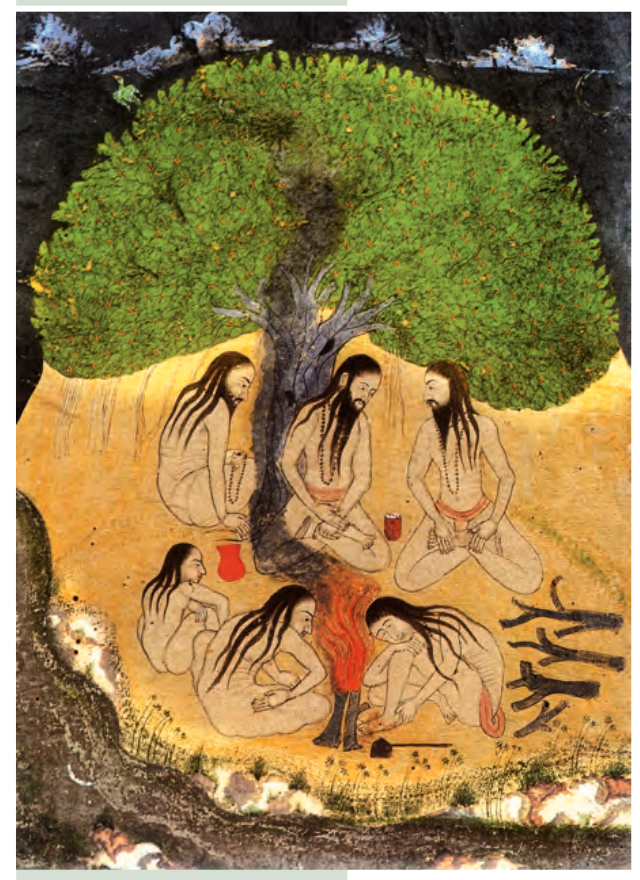
Fig. 3
A fireside gathering of ascetics.
Islam and Sufism
The sants had much in common with the Sufis, so much so that it is believed that they adopted many ideas of each other. Sufis were Muslim mystics. They rejected outward religiosity and emphasised love and devotion to God and compassion towards all fellow human beings.
Islam propagated strict monotheism or submission to one God. In the eighth and ninth centuries religious scholars developed different aspects of the Holy Law (Shariat) and theology of Islam. While the religion of Islam gradually became more complex, Sufis provided it with an additional dimension that favoured a more personal devotion to God. The Sufis often rejected the elaborate rituals and codes of behaviour demanded by Muslim religious scholars. They sought union with God much as a lover seeks his beloved with a disregard for the world. Like the saint-poets, the Sufis too composed poems expressing their feelings, and a rich literature in prose, including anecdotes and fables, developed around them. Among the great Sufis of Central Asia were Ghazzali, Rumi and Sadi. Like the Nathpanthis, Siddhas and Yogis, the Sufis too believed that the heart can be trained to look at the world in a different way. They developed elaborate methods of training using zikr (chanting of a name or sacred formula), contemplation, sama (singing), raqs (dancing), discussion of parables, breath control, etc. under the guidance of a master or pir. Thus emerged the silsilas, a spiritual genealogy of Sufi teachers, each following a slightly different method (tariqa) of instruction and ritual practice.

Fig. 4
Mystics in ecstasy.
In Kashmir the Rishi order of Sufism flourished in the 15th and 16th centuries. This order was established by Sheikh Nuruddin Wali also known as Nund Rishi and had a deep impact on the life of the people in Kashmir. A number of shrines dedicated to Rishi saints can be found in many parts of Kashmir.
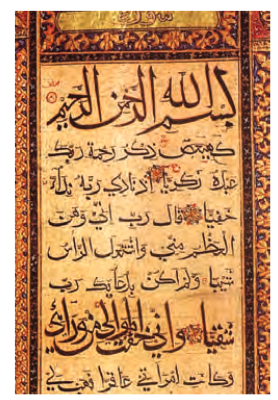
Fig. 5
A page from a manuscript of the Quran, Deccan, late fifteenth century.
A large number of Sufis from Central Asia settled in Hindustan from the eleventh century onwards. This process was strengthened with the establishment of the Delhi Sultanate (Chapter 3), when several major Sufi centres developed all over the subcontinent. The Chishti silsila was among the most influential orders. It had a long line of teachers like Khwaja Muinuddin Chishti of Ajmer, Qutbuddin Bakhtiar Kaki of Delhi, Baba Farid of Punjab, Khwaja Nizamuddin Auliya of Delhi and Bandanawaz Gisudaraz of Gulbarga.
The Sufi masters held their assemblies in their khanqahs or hospices. Devotees of all descriptions including members of the royalty and nobility, and ordinary people flocked to these khanqahs. They discussed spiritual matters, sought the blessings of the saints in solving their worldly problems, or simply attended the music and dance sessions.
Hospice
House of rest for travellers, especially one kept by a religious order.
Often people attributed Sufi masters with miraculous powers that could relieve others of their illnesses and troubles. The tomb or dargah of a Sufi saint became a place of pilgrimage to which thousands of people of all faiths thronged.
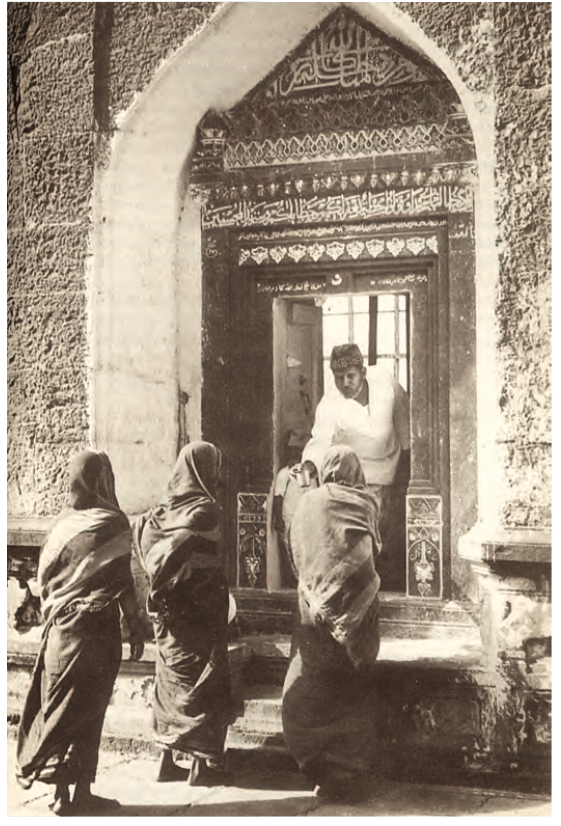
Fig. 6
Devotees of all backgrounds visit Sufi shrines.
Jalaluddin Rumi was a great thirteenth-century Sufi poet from Iran who wrote in Persian. Here is an excerpt from his work:
He was not on the Cross of the Christians. I went to the Hindu temples. In none of them was there any sign. He was not on the heights or in the lowlands … I went to the Kaaba of Mecca. He was not there. I asked about him from Avicenna the philosopher. He was beyond the range of Avicenna … I looked into my heart. In that, his place, I saw him. He was in no other place.
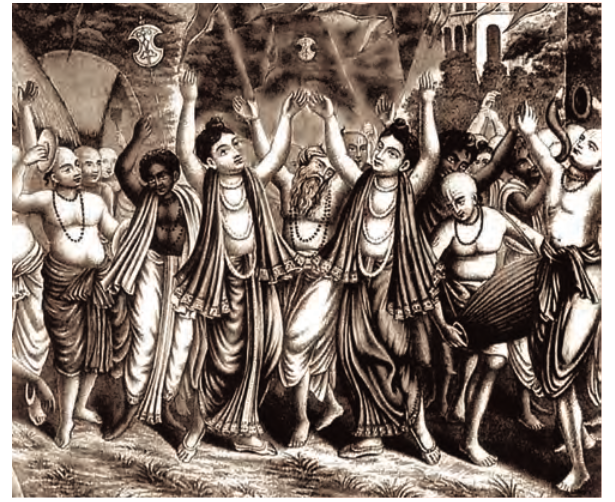
Fig. 7
Chaitanyadeva, a sixteenth-century bhakti saint from Bengal, preached selfless devotion to Krishna-Radha. In the picture you see a group of his followers engaged in ecstatic dancing and singing
Some of them like Kabir and Baba Guru Nanak rejected all orthodox religions. Others like Tulsidas and Surdas accepted existing beliefs and practices but wanted to make these accessible to all. Tulsidas conceived of God in the form of Rama. Tulsidas’s composition, the Ramcharitmanas, written in Awadhi (a language used in eastern Uttar Pradesh), is important both as an expression of his devotion and as a literary work. Surdas was an ardent devotee of Krishna. His compositions, compiled in the Sursagara, Surasaravali and Sahitya Lahari, express his devotion. Also contemporary was Shankaradeva of Assam (late fifteenth century) who emphasised devotion to Vishnu, and composed poems and plays in Assamese. He began the practice of setting up namghars or houses of recitation and prayer, a practice that continues to date.
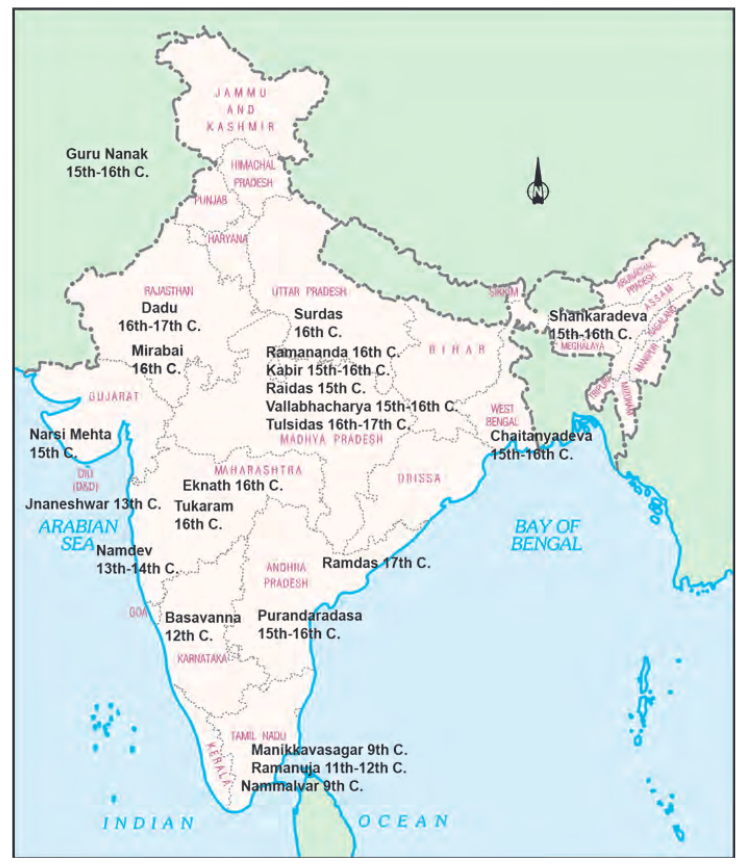
Map 1
Major bhakti saints and the regions associated with them.
The essence of Shankaradeva’s devotion came to be known as Eka Sarana Nama Dharma(supreme surrender to the One). The teachings of Shankaradeva were based on the Bhagavad Gita and Bhagavata Purana. He also encouraged the establishment of satra or monasteries for transmission of knowledge. His major compositions included Kirtana-ghosha.
This tradition also included saints like Dadu Dayal, Ravidas and Mirabai. Mirabai was a Rajput princess married into the royal family of Mewar in the sixteenth century. Mirabai became a disciple of Ravidas, a saint from a caste considered “untouchable”. She was devoted to Krishna and composed innumerable bhajans expressing her intense devotion. Her songs also openly challenged the norms of the “upper” castes and became popular with the masses in Rajasthan and Gujarat.
An important contribution of Bhakti saints was towards the development of music. Jayadeva of Bengal composed the Gita Govinda in Sanskrit, each song composed in a particular raga andtala. A significant impact that these saints had on music was the use of bhajan, kirtan andabhang. These songs which emphasised on emotional experience had a tremendous appeal to the common people.
A unique feature of most of the saints is that their works were composed in regional languages and could be sung. They became immensely popular and were handed down orally from generation to generation. Usually the poorest, most deprived communities and women transmitted these songs, often adding their own experiences. Thus the songs as we have them today are as much a creation of the saints as of generations of people who sang them. They have become a part of our living popular culture.
Beyond the Rana’s palace
This is a song composed by Mirabai:
Ranaji, I have left your norms of shame,
and false decorum of the princely life.
I have left your town.
And yet Rana why have you kept up enmity against me?
Rana you gave me a cup of poison.
I drank it laughing.
Rana I will not be destroyed by you.
And yet Rana why have you kept up enmity against me?
Why do you think Mirabai left the Rana’s palace?
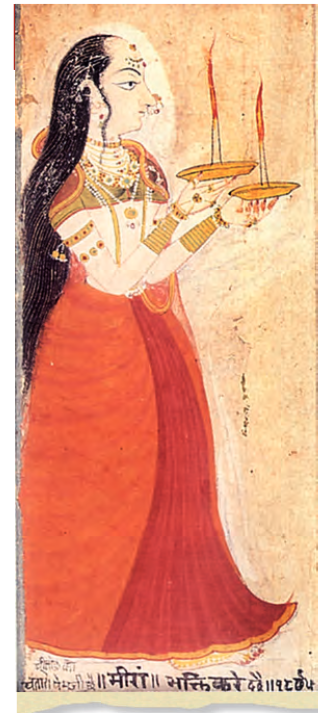
Fig. 8
Mirabai.
A Closer Look: Kabir
Kabir, who probably lived in the fifteenth-sixteenth centuries, was one of the most influential saints. He was brought up in a family of Muslim julahas or weavers settled in or near the city of Benares (Varanasi). We have little reliable information about his life. We get to know of his ideas from a vast collection of verses called sakhis and pads said to have been composed by him and sung by wandering bhajan singers. Some of these were later collected and preserved in the Guru Granth Sahib, Panch Vani and Bijak.
In search of the True Lord
Here is a composition of Kabir:
O Allah-Ram present in all living beings
Have mercy on your servants, O Lord!
Why bump your head on the ground,
Why bathe your body in water?
You kill and you call yourself “humble”
But your vices you conceal.
Twenty-four times the Brahmana keeps the ekadasi fast
While the Qazi observes the Ramzan
Tell me why does he set aside the eleven months
To seek spiritual fruit in the twelfth?
Hari dwells in the East, they say
And Allah resides in the West,
Search for him in your heart, in the heart of your heart;
There he dwells, Rahim-Ram.
In what ways are the ideas in this poem similar to or different from those of Basavanna and Jalaluddin Rumi?
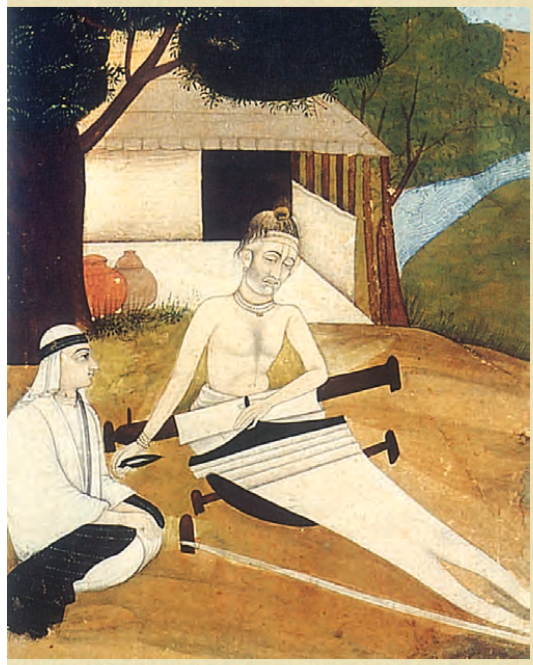
Fig. 9
Kabir working on a loom.
Kabir’s teachings were based on a complete, indeed vehement, rejection of the major religious traditions. His teachings openly ridiculed all forms of external worship of both Brahmanical Hinduism and Islam, the pre-eminence of the priestly classes and the caste system. The language of his poetry was a form of spoken Hindi widely understood by ordinary people. He also sometimes used cryptic language, which is difficult to follow.
A Closer Look: Baba Guru Nanak
We know more about Baba Guru Nanak (1469-1539) than about Kabir. Born at Talwandi (Nankana Sahib in Pakistan), he travelled widely before establishing a centre at Kartarpur (Dera Baba Nanak on the river Ravi). A regular worship that consisted of the singing of his own hymns was established there for his followers. Irrespective of their former creed, caste or gender, his followers ate together in the common kitchen (langar). The sacred space thus created by Baba Guru Nanak was known as dharmsal. It is now known as Gurdwara.
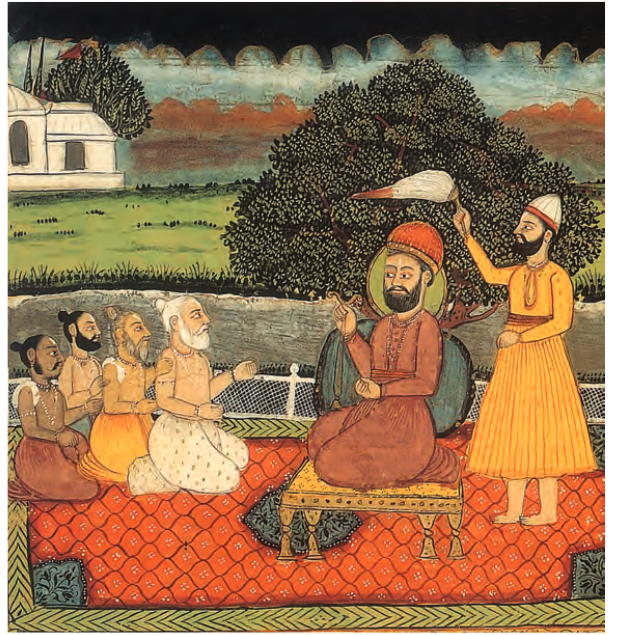
Fig. 10
Baba Guru Nanak as a young man, in discussion with holy men.
Before his death in 1539, Baba Guru Nanak appointed one of his followers as his successor. His name was Lehna but he came to be known as Guru Angad, signifying that
he was a part of Baba Guru Nanak himself. Guru Angad compiled the compositions of Baba Guru Nanak, to which he added his own in a new script known as Gurmukhi. The three successors of Guru Angad also wrote under the name of “Nanak” and all of their compositions were compiled by Guru Arjan in 1604. To this compilation were added the writings of other figures like Shaikh Farid, Sant Kabir, Bhagat Namdev and Guru Tegh Bahadur. In 1706 this compilation was authenticated by Guru Tegh Bahadur’s son and successor, Guru Gobind Singh. It is now known as Guru Granth Sahib, the holy scripture of the Sikhs.
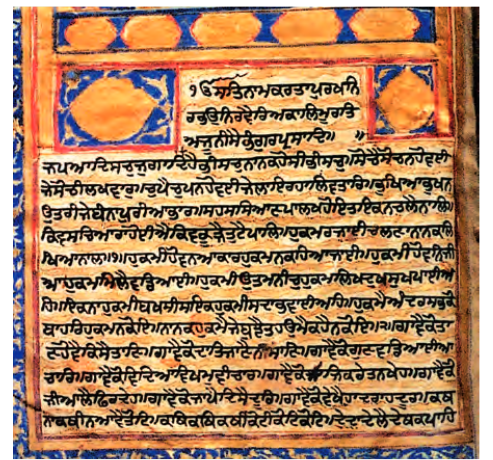
Fig. 11
An early manuscript of the Guru Granth Sahib
The number of Baba Guru Nanak’s followers increased through the sixteenth century under his successors. They belonged to a number of castes but traders, agriculturists, artisans and craftsmen predominated. This may have something to do with Baba Guru Nanak’s insistence that his followers must be householders and should adopt productive and useful occupations. They were also expected to contribute to the general funds of the community of followers.
By the beginning of the seventeenth century the town of Ramdaspur (Amritsar) had developed around the central Gurdwara called Harmandar Sahib (Golden Temple). It was virtually self-governing and modern historians refer to the early-seventeenth-century Sikh community as ‘a state within the state’. The Mughal emperor Jahangir looked upon them as a potential threat and he ordered the execution of Guru Arjan in 1606. The Sikh movement began to get politicised in the seventeenth century, a development which culminated in the institution of the Khalsa by Guru Gobind Singh in 1699. The community of the Sikhs, called the Khalsa Panth, became a political entity.
The changing historical situation during the sixteenth and seventeenth centuries influenced the development of the Sikh movement. The ideas of Baba Guru Nanak had a huge impact on this development from the very beginning. He emphasised the importance of the worship of one God. He insisted that caste, creed or gender was irrelevant for attaining liberation. His idea of liberation was not that of a state of inert bliss but rather the pursuit of active life with a strong sense of social commitment. He himself used the terms nam, dan and isnan for the essence of his teaching, which actually meant right worship, welfare of others and purity of conduct. His teachings are now remembered as nam-japna, kirt-karna and vand-chhakna, which also underline the importance of right belief and worship, honest living, and helping others. Thus, Baba Guru Nanak’s idea of equality had social and political implications. This might partly explain the difference between the history of the followers of Baba Guru Nanak and the history of the followers of the other religious figures of the medieval centuries, like Kabir, Ravidas and Dadu whose ideas were very similar to those of Baba Guru Nanak.
ELSEWHERE
Martin Luther and the Reformation
The sixteenth century was a time of religious ferment in Europe as well. One of the most important leaders of the changes that took place within Christianity was Martin Luther (1483-1546). Luther felt that several practices in the Roman Catholic Church went against the teachings of the Bible. He encouraged the use of the language of ordinary people rather than Latin, and translated the Bible into German. Luther was strongly opposed to the practice of “indulgences” or making donations to the Church so as to gain forgiveness from sins. His writings were widely disseminated with the growing use of the printing press. Many Protestant Christian sects trace their origins to the teachings of Luther.
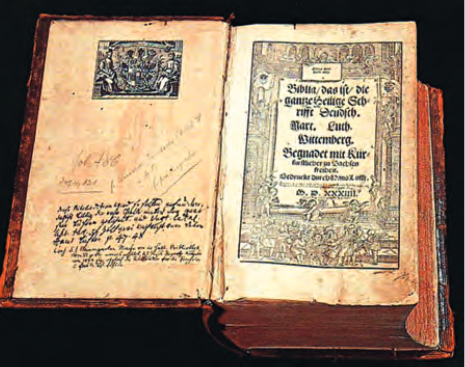
Fig. 12
Title page of the German Bible translated by Martin Luther.

Imagine
You are attending a meeting where a saint is discussing the caste system. Relate the conversation.
KEYWORDS
Virashaivism
bhakti
Sufi
khanqah
Let’s recall
1. Match the following:
| The Buddha | namghar |
| Shankaradeva | worship of Vishnu |
| Nizamuddin Auliya | questioned social differences |
| Nayanars | Sufi saint |
| Alvars | worship of Shiva |
2. Fill in the blanks:
(a) Shankara was an advocate of ————-.
(b) Ramanuja was influenced by the —————.
(c) ————, ———— and ———— were advocates of Virashaivism.
(d) ———————— was an important centre of the Bhakti tradition in Maharashtra.
3. Describe the beliefs and practices of the Nathpanthis, Siddhas and Yogis.
4. What were the major ideas expressed by Kabir? How did he express these?
Let’s understand
5. What were the major beliefs and practices of the Sufis?
6. Why do you think many teachers rejected prevalent religious beliefs and practices?
7. What were the major teachings of Baba Guru Nanak?
Let’s discuss
8. For either the Virashaivas or the sants of Maharashtra, discuss their attitude towards caste.
9. Why do you think ordinary people preserved the memory of Mirabai?
Let’s do
10. Find out whether in your neighbourhood there are any dargahs, gurudwaras or temples associated with saints of the bhakti tradition in your neighbourhood. Visit any one of these and describe what you see and hear.
11. For any of the saint-poets whose compositions have been included in this chapter, find out more about their works, noting down other poems. Find out whether these are sung, how they are sung, and what the poets wrote about.
12. There are several saint-poets whose names have been mentioned but their works have not been included in the chapter. Find out more about the language in which they composed, whether their compositions were sung, and what their compositions were about.
